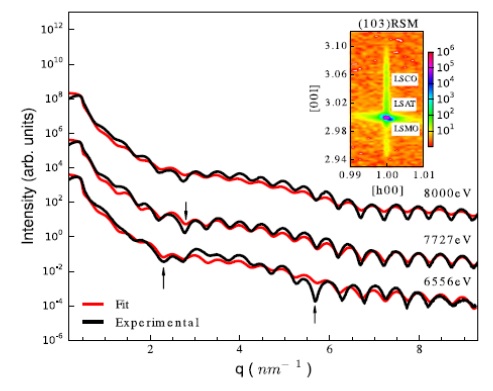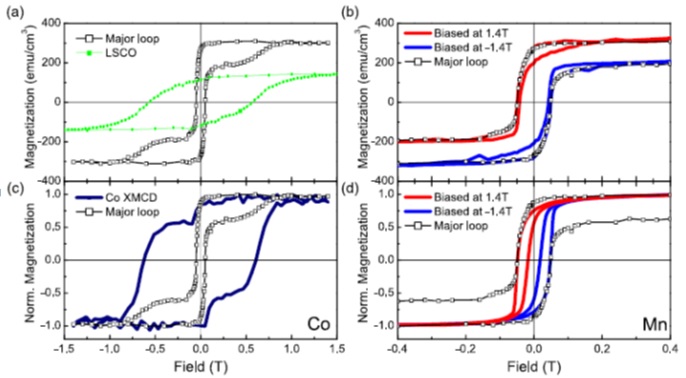Interfacial magnetic interactions between ferromagnetic/antiferromagnetic (FM/AFM) and FM/FM materials play a key role in numerous magnetic technologies such as high performance permanent magnets and magnetic read heads. High performance permanent magnets with large coercivity and high magnetization can be realized through interfacial coupling between two FM layers, where one layer is magnetically hard, i.e. with large coercivity and low magnetization, and the second layer is magnetically soft, i.e. with low coercivity and high magnetization. This type of interfacial interaction is termed exchange spring behavior and it is usually characterized by the pinning of the magnetic moments of the soft FM layer at the interface with the hard FM layer. Upon field reversal after saturation, the unpinned moments of the soft FM layer are free to rotate in a twisting fashion towards an antiparallel alignment with the hard layer, and then spring back into parallel alignment upon field removal.

While most studies on exchange spring behavior have been focused on metallic FM alloys, perovskite oxides with the chemical formula ABO3 may offer several advantages such as their highly tunable properties through the competition between the charge, lattice, spin, and orbital degrees of freedom. In this work, researchers from the University of California – Davis, the Advanced Light Source (ALS), and the Stanford Synchrotron Radiation Lightsource (SSRL), reported a novel form of exchange spring behavior in epitaxial La0.67Sr0.33MnO3 (LSMO) / La0.67Sr0.33CoO3 (LSCO) bilayers. Resonant x-ray reflectivity (XRR) measurements were performed using BL2-1 at SSRL by tuning the x-ray energy to 8000 eV and at energies near the Mn and Co K edges, where the x-ray fluorescence from the sample just begins to rise rapidly, 6556 eV and 7727 eV, respectively. As shown in Fig. 1, these resonant XRR spectra show clear Kiessig fringes from finite thickness effects as well as energy dependent features indicated by arrows. Careful fitting of the resonant XRR curves using Bruker LEPTOS software allowed for the determination of key structural parameters, such as the individual layer thicknesses, interface roughness and density. The resonant XRR technique is a particularly powerful, non-destructive technique for obtaining quantitative values for these structural parameters for layers with similar densities but which differ chemically. Reciprocal space maps of the {103} family of reflections (e.g. inset to Fig. 1) show that the film is fully coherent with the underlying substrate with a high degree of crystallinity.

The magnetic characterization of the bilayers was carried out through a combination of bulk magnetometry using a superconducting quantum interference device (SQUID) magnetometer and soft x-ray magnetic circular dichroism (XMCD) performed using BL 6.3.1 at the ALS. This latter technique allows for element specific characterization of the magnetic properties of the individual layers, as well as characterization of the valence states and local bonding environment of the transition metal ions. As shown in Fig. 2(a), the SQUID major loops show two distinct switching events, which would typically be associated with the soft LSMO layer and the hard LSCO layer. However, XMCD hysteresis loops measured at the Co L edge (Fig. 2(c)) shows that a portion of the LSCO layer is magnetically distinct from the majority of the hard LSCO layer, and rather rotates with the LSMO layer at small fields. To probe the exchange spring behavior, the bilayers were biased to either +1.4 T or – 1.4 T (to align both the soft and hard layers), and minor hysteresis loops were measured between +/- 0.4 T (i.e. below the transition field for the hard LSCO layer). Both the SQUID minor loops (Fig. 2(b)) and the XMCD minor loops (Fig. 2(d)) measured at the Mn L edge follow the trace of the major loop with a lateral shift which points in the direction opposite to the biasing field. An additional vertical shift is observed in the SQUID minor loops due to the portion of the LSCO magnetization which remained fixed along the direction of the biasing field and was not affected by the sweeping field. The lateral shifts result from the pinning of the soft LSMO moments by the hard LSCO layer as expected in an exchange spring system, however a pronounced hysteresis can be observed in the Mn XMCD loops (Fig. 2(d)). This hysteresis indicates that irreversible switching of the soft LSMO layer is involved upon field reversal, unlike case for metallic FM systems which spring back into parallel alignment upon field removal.
Both of these unusual features in the exchange spring behavior of the LSMO/LSCO system, i.e. the concurrent switching of an interfacial LSCO layer with the LSMO layer, and the pronounced hysteresis of the LSMO layer, have been ascribed to a charge transfer process at the LSMO/LSCO interface. X-ray absorption spectroscopy (XAS) showed that the electronic structure of the bilayers have additional spectral features associated with Mn4+ and Co2+ ions in octahedral coordination, beyond the Mn3+/Mn4+ and Co3+/Co4+ ratios expected from the La/Sr doping levels. As a result, it is possible that a FM superexchange interaction develops along Mn4+ - O2- - Co2+ chains which favors stronger exchange coupling of the interfacial LSCO layer to the LSMO layer than to the rigid part of the LSCO layer. These results highlight the unique tunability of magnetic properties in complex oxide systems through indirect exchange interactions between transition metal ions that hold multiple valence/spin states, which are not commonly found in FM metal systems implemented in current technologies.
B. Li, R. V. Chopdekar, E. Arenholz, A. Mehta and Y. Takamura, "Unconventional Switching Behavior in La0.7Sr0.3MnO3/La0.7Sr0.3CoO3 Exchange-spring Bilayers", Appl. Phys. Lett. 105, 202401 (2014), DOI: 10.1063/1.4902115.




